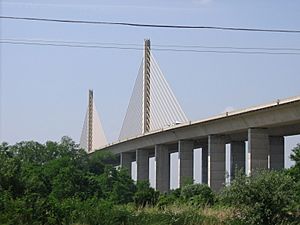Senator William V. Roth Jr. Bridge facts for kids
Quick facts for kids Senator William V. Roth Jr. Bridge |
|
|---|---|
 |
|
| Coordinates | 39°32′59″N 75°39′23″W / 39.549722°N 75.656501°W |
| Carries | 6 lanes of |
| Crosses | Chesapeake & Delaware Canal |
| Locale | St. Georges, Delaware |
| Other name(s) | Chesapeake & Delaware Canal Bridge, New St. Georges Bridge |
| Maintained by | U.S. Army Corps of Engineers |
| Characteristics | |
| Design | Cable-stayed bridge |
| Total length | 4,650 feet (1,417 m) |
| Width | 127 feet (39 m) |
| Longest span | 750 feet (229 m) |
| Clearance below | 138 feet (42.1 m) |
| History | |
| Construction begin | 1991 |
| Construction end | 1994 |
| Opened | December 23, 1995 |
The Senator William V. Roth Jr. Bridge is a large bridge in Delaware. It is also known as the Roth Bridge or the Chesapeake & Delaware Canal Bridge. This bridge is made of concrete and steel. It is a special type called a cable-stayed bridge. It crosses over the Chesapeake & Delaware Canal near St. Georges, Delaware.
The bridge is part of Delaware Route 1. It runs next to the St. Georges Bridge, which carries U.S. Route 13. In 2006, the bridge was named after William V. Roth, Jr.. He was a U.S. Senator who helped get money from the government to build the bridge. The U.S. Army Corps of Engineers owns and takes care of the bridge. Even though there is a toll booth nearby, you do not have to pay to cross the Roth Bridge.
Contents
Building the Roth Bridge
Why a New Bridge Was Needed
In the 1980s, people started thinking about building a new bridge. The old St. Georges Bridge was getting old. Delaware's former Governor, Michael N. Castle, looked into building a new way to cross the canal.
At the same time, plans were being made to improve U.S. Route 13. This road was often too busy. The new bridge became part of a plan for a new, faster highway. This new highway would help traffic flow better.
Construction and Opening
It took about ten years to get all the plans approved. Construction on the new highway and bridge began in 1992. The highway north of the bridge was first called Delaware Route 7. But once the bridge was finished, it became part of Delaware Route 1.
The Senator William V. Roth Jr. Bridge opened on December 9, 1995. The new highway also opened at the same time.
Changes After Opening
After the Roth Bridge opened, U.S. Route 13 was moved onto the new bridge. The old St. Georges Bridge was supposed to be taken down. But people in the area wanted to save it. So, the St. Georges Bridge was fixed up instead. It got new paint, a new road surface, and other repairs.
After these repairs, which lasted from 1998 to 2001, U.S. Route 13 moved back to the St. Georges Bridge. The new highway was planned to be a toll road. But it was decided to put the toll booths past the exit for U.S. Route 13. This way, both bridges crossing the canal would remain free to use.
In December 2018, the St. Georges Bridge closed for repairs. During this time, U.S. Route 13 traffic used the Roth Bridge temporarily.
Bridge Design and Features
A Special Type of Bridge
The Senator William V. Roth Jr. Bridge is the first cable-stayed bridge in the Delaware Valley area. Other bridges there are different types, like suspension bridges. It was also the first bridge in the United States built using pre-cast concrete sections. This means parts of the bridge were made somewhere else and then brought to the site.
The bridge's design is similar to the Sunshine Skyway Bridge in St. Petersburg, Florida. It has many features that make it unique:
- It is a fixed high-level bridge. This means it doesn't open for boats. It has a clearance of 100 feet (about 30 meters) above the water.
- The main part of the bridge is 750 feet (about 229 meters) long. Its main supports are out of the water. This helps prevent big accidents with ships.
- It has six lanes for traffic. It could even be changed to have eight lanes if needed.
- There are emergency pull-off areas on both sides of the road.
- The bridge used to have roadway lights. These were removed in 2003. Now, special floodlights light up the main support towers.
- The speed limit on the bridge is 65 miles per hour (about 105 kilometers per hour).
- The parts of the bridge leading up to the main section are separate. They only join where the cables are anchored.
How it was Built
The bridge was built between 1991 and 1994. Large concrete pieces were made in Cape Charles, Virginia. These pieces were then brought by barge to the construction site. Once at the site, the sections were put together like a giant jigsaw puzzle. The bridge also has a 3% climbing grade. This means it goes uphill slightly, which is a feature the nearby St. Georges Bridge does not have.
Awards
The Senator William V. Roth Jr. Bridge has won awards for its design and construction.
- In 1995, it received the Harry H. Edwards Award from the Precast Concrete Institute.
Images for kids


